Report on Accounting and Finance: Analysis of Three Companies
VerifiedAdded on 2021/02/20
|19
|4303
|74
Report
AI Summary
This comprehensive report provides an overview of key concepts in accounting and finance, including financial accounting, financial management, and management accounting. The report is divided into three parts, each focusing on a different company: YARNSHAW LIMITED, RECKTURK PLC, and ROSEVILLE PLC. Part A covers the preparation of a profit and loss statement and balance sheet for YARNSHAW LIMITED, including working notes for calculations. Part B analyzes RECKTURK PLC, calculating the break-even point and margin of safety, and evaluating the impact of marketing expenses on sales and profit. Part C focuses on ROSEVILLE PLC, recommending acceptance or rejection of capital budgeting projects using investment appraisal techniques and discussing the merits and limitations of budgets as a strategic planning tool. The report concludes with a discussion of the assumptions used in break-even analysis and provides relevant references.
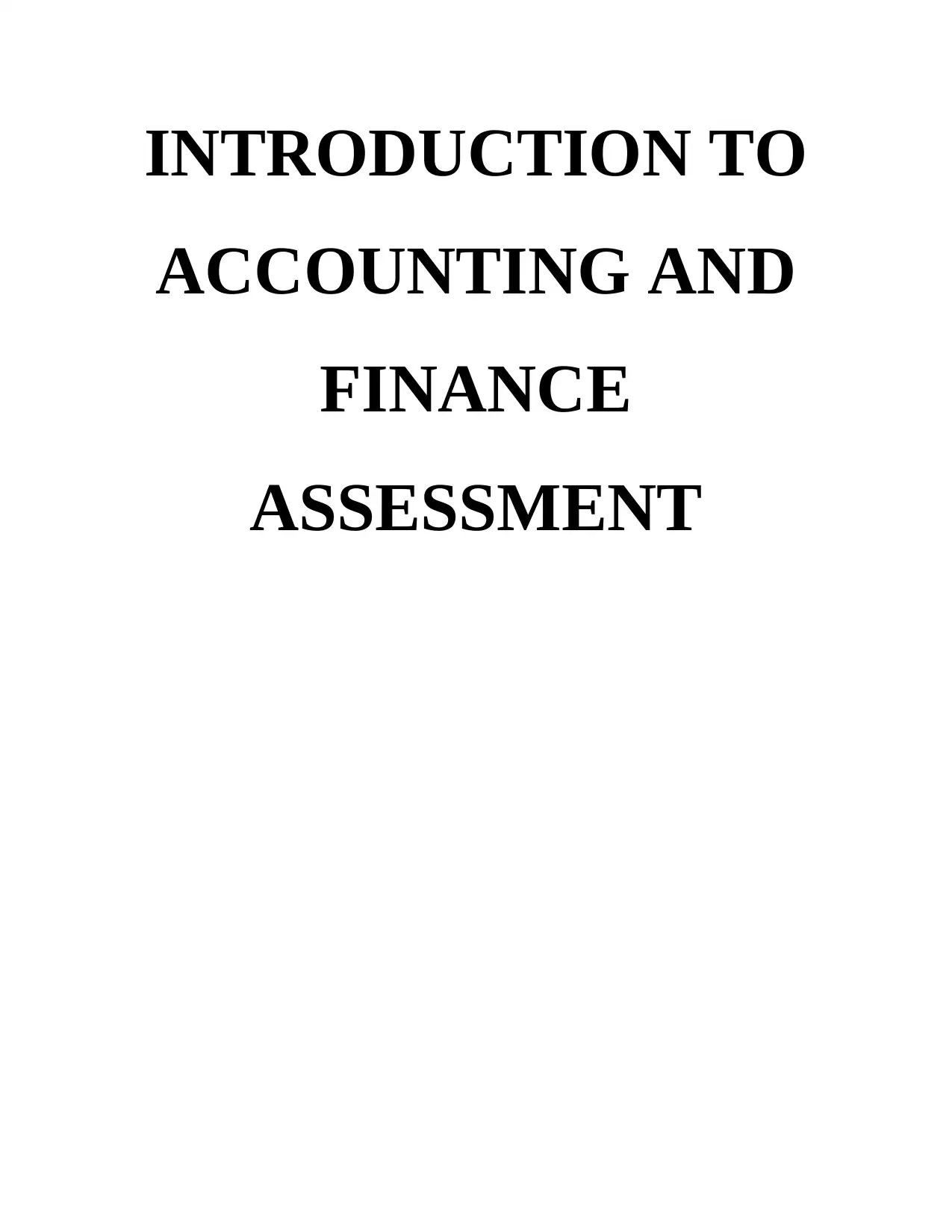
INTRODUCTION TO
ACCOUNTING AND
FINANCE
ASSESSMENT
ACCOUNTING AND
FINANCE
ASSESSMENT
Paraphrase This Document
Need a fresh take? Get an instant paraphrase of this document with our AI Paraphraser
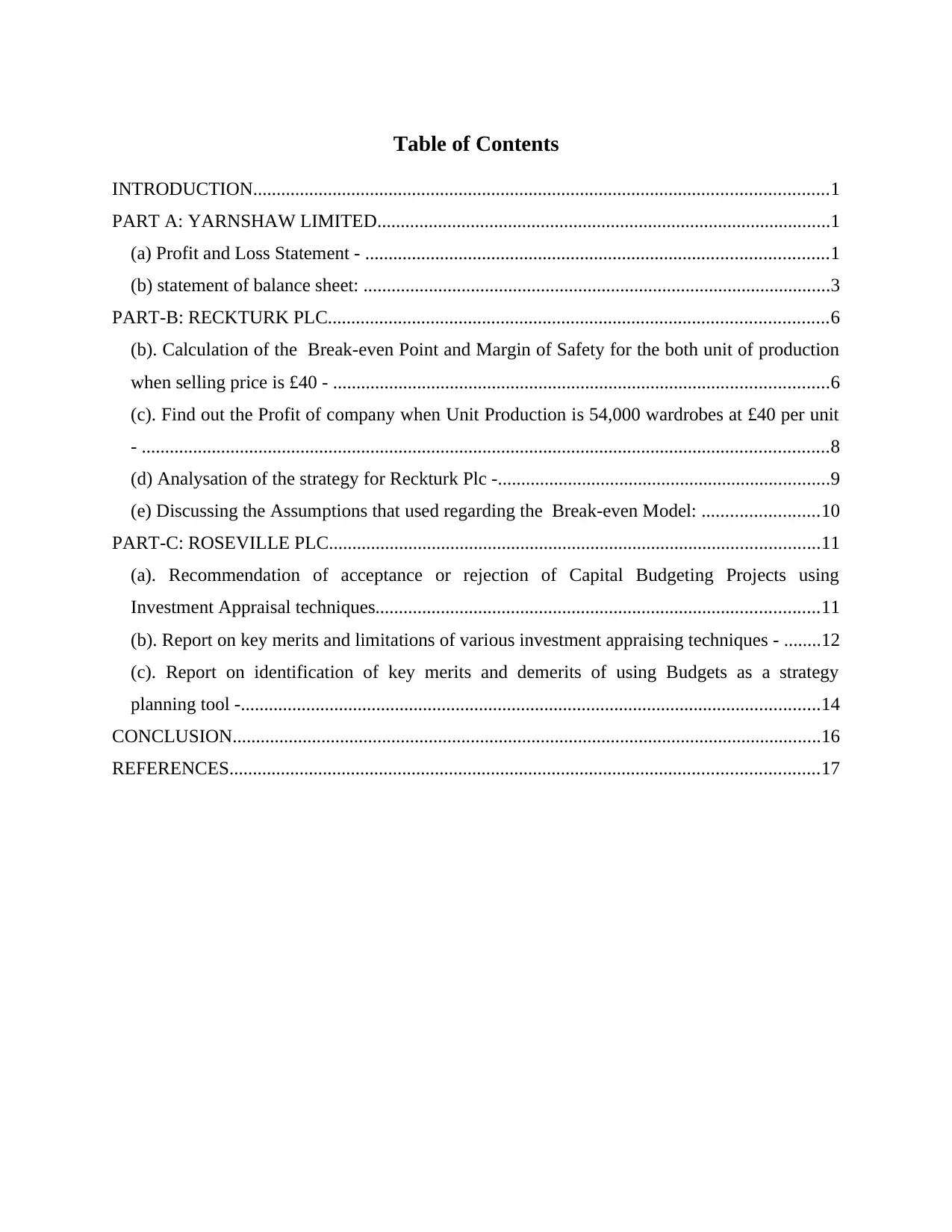
Table of Contents
INTRODUCTION...........................................................................................................................1
PART A: YARNSHAW LIMITED.................................................................................................1
(a) Profit and Loss Statement - ...................................................................................................1
(b) statement of balance sheet: ....................................................................................................3
PART-B: RECKTURK PLC...........................................................................................................6
(b). Calculation of the Break-even Point and Margin of Safety for the both unit of production
when selling price is £40 - ..........................................................................................................6
(c). Find out the Profit of company when Unit Production is 54,000 wardrobes at £40 per unit
- ...................................................................................................................................................8
(d) Analysation of the strategy for Reckturk Plc -.......................................................................9
(e) Discussing the Assumptions that used regarding the Break-even Model: .........................10
PART-C: ROSEVILLE PLC.........................................................................................................11
(a). Recommendation of acceptance or rejection of Capital Budgeting Projects using
Investment Appraisal techniques...............................................................................................11
(b). Report on key merits and limitations of various investment appraising techniques - ........12
(c). Report on identification of key merits and demerits of using Budgets as a strategy
planning tool -............................................................................................................................14
CONCLUSION..............................................................................................................................16
REFERENCES..............................................................................................................................17
INTRODUCTION...........................................................................................................................1
PART A: YARNSHAW LIMITED.................................................................................................1
(a) Profit and Loss Statement - ...................................................................................................1
(b) statement of balance sheet: ....................................................................................................3
PART-B: RECKTURK PLC...........................................................................................................6
(b). Calculation of the Break-even Point and Margin of Safety for the both unit of production
when selling price is £40 - ..........................................................................................................6
(c). Find out the Profit of company when Unit Production is 54,000 wardrobes at £40 per unit
- ...................................................................................................................................................8
(d) Analysation of the strategy for Reckturk Plc -.......................................................................9
(e) Discussing the Assumptions that used regarding the Break-even Model: .........................10
PART-C: ROSEVILLE PLC.........................................................................................................11
(a). Recommendation of acceptance or rejection of Capital Budgeting Projects using
Investment Appraisal techniques...............................................................................................11
(b). Report on key merits and limitations of various investment appraising techniques - ........12
(c). Report on identification of key merits and demerits of using Budgets as a strategy
planning tool -............................................................................................................................14
CONCLUSION..............................................................................................................................16
REFERENCES..............................................................................................................................17

⊘ This is a preview!⊘
Do you want full access?
Subscribe today to unlock all pages.

Trusted by 1+ million students worldwide

INTRODUCTION
Introduction to accounting and finance provides a introductory yet comprehensive
overview of the financial accounting, financial management and management accounting. This
provides accounting and finance function to the business in order to making the decision by
measuring the financial data and information (Nowak, 2016). Accounting is main field of the
business in which business activities and transactions are identified in the monetary terms and
recorded in the books of accounts. Whereas finance is related to the presented of the final
accounts to the management and investor by using the financial information and data. It enables
to management of the financial resources and its disbursement in a appropriate manner and
management of the company can make the better decision regarding the future to sustain the
business in long run. This particular report of the accounting and finance covers the various
topic such as accounting standard and principle that is used in the financial accounting. It also
includes the preparation of the income statement and balance sheet of the mentioned company.
It further includes cost techniques like break even point, margin of safety and the investment
appraisal or capital budgeting tools. In addition to advantage and limitation of the budget as
strategies techniques that is analysed by management.
PART A: YARNSHAW LIMITED
(a) Profit and Loss Statement -
This is the particular sheet that is prepared by the administration by recording the
business transactions and activities. It shows the revenue and expenses in order to compute the
net profit for a specific time of period. Income statement is prepared in order to ascertain the net
profit by taking the certain information regarding the revenue, sales, depreciation, tax etc. In the
same sense the company, income statement of the Yarnshaw Ltd are as under:
Income statements for the company Yarnshaw Ltd:
Statement of profit and loss for the year ended December 31, 2018
Particulars Amount (£) Particulars Amount (£)
To Opening Stock NA By Revenue 759600
To Purchases 630000 By Closing Stock 273600
To Wages 143010
1
Introduction to accounting and finance provides a introductory yet comprehensive
overview of the financial accounting, financial management and management accounting. This
provides accounting and finance function to the business in order to making the decision by
measuring the financial data and information (Nowak, 2016). Accounting is main field of the
business in which business activities and transactions are identified in the monetary terms and
recorded in the books of accounts. Whereas finance is related to the presented of the final
accounts to the management and investor by using the financial information and data. It enables
to management of the financial resources and its disbursement in a appropriate manner and
management of the company can make the better decision regarding the future to sustain the
business in long run. This particular report of the accounting and finance covers the various
topic such as accounting standard and principle that is used in the financial accounting. It also
includes the preparation of the income statement and balance sheet of the mentioned company.
It further includes cost techniques like break even point, margin of safety and the investment
appraisal or capital budgeting tools. In addition to advantage and limitation of the budget as
strategies techniques that is analysed by management.
PART A: YARNSHAW LIMITED
(a) Profit and Loss Statement -
This is the particular sheet that is prepared by the administration by recording the
business transactions and activities. It shows the revenue and expenses in order to compute the
net profit for a specific time of period. Income statement is prepared in order to ascertain the net
profit by taking the certain information regarding the revenue, sales, depreciation, tax etc. In the
same sense the company, income statement of the Yarnshaw Ltd are as under:
Income statements for the company Yarnshaw Ltd:
Statement of profit and loss for the year ended December 31, 2018
Particulars Amount (£) Particulars Amount (£)
To Opening Stock NA By Revenue 759600
To Purchases 630000 By Closing Stock 273600
To Wages 143010
1
Paraphrase This Document
Need a fresh take? Get an instant paraphrase of this document with our AI Paraphraser
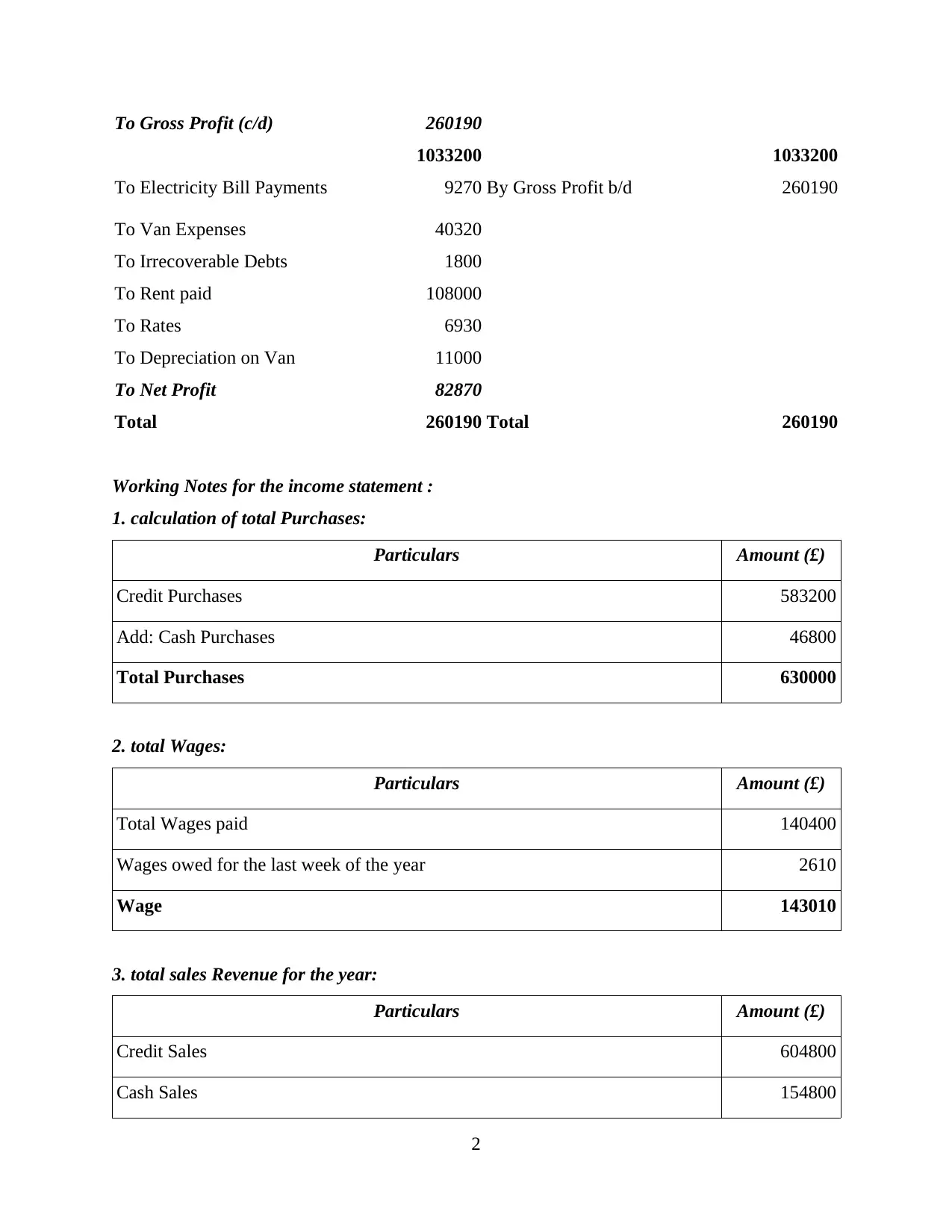
To Gross Profit (c/d) 260190
1033200 1033200
To Electricity Bill Payments 9270 By Gross Profit b/d 260190
To Van Expenses 40320
To Irrecoverable Debts 1800
To Rent paid 108000
To Rates 6930
To Depreciation on Van 11000
To Net Profit 82870
Total 260190 Total 260190
Working Notes for the income statement :
1. calculation of total Purchases:
Particulars Amount (£)
Credit Purchases 583200
Add: Cash Purchases 46800
Total Purchases 630000
2. total Wages:
Particulars Amount (£)
Total Wages paid 140400
Wages owed for the last week of the year 2610
Wage 143010
3. total sales Revenue for the year:
Particulars Amount (£)
Credit Sales 604800
Cash Sales 154800
2
1033200 1033200
To Electricity Bill Payments 9270 By Gross Profit b/d 260190
To Van Expenses 40320
To Irrecoverable Debts 1800
To Rent paid 108000
To Rates 6930
To Depreciation on Van 11000
To Net Profit 82870
Total 260190 Total 260190
Working Notes for the income statement :
1. calculation of total Purchases:
Particulars Amount (£)
Credit Purchases 583200
Add: Cash Purchases 46800
Total Purchases 630000
2. total Wages:
Particulars Amount (£)
Total Wages paid 140400
Wages owed for the last week of the year 2610
Wage 143010
3. total sales Revenue for the year:
Particulars Amount (£)
Credit Sales 604800
Cash Sales 154800
2
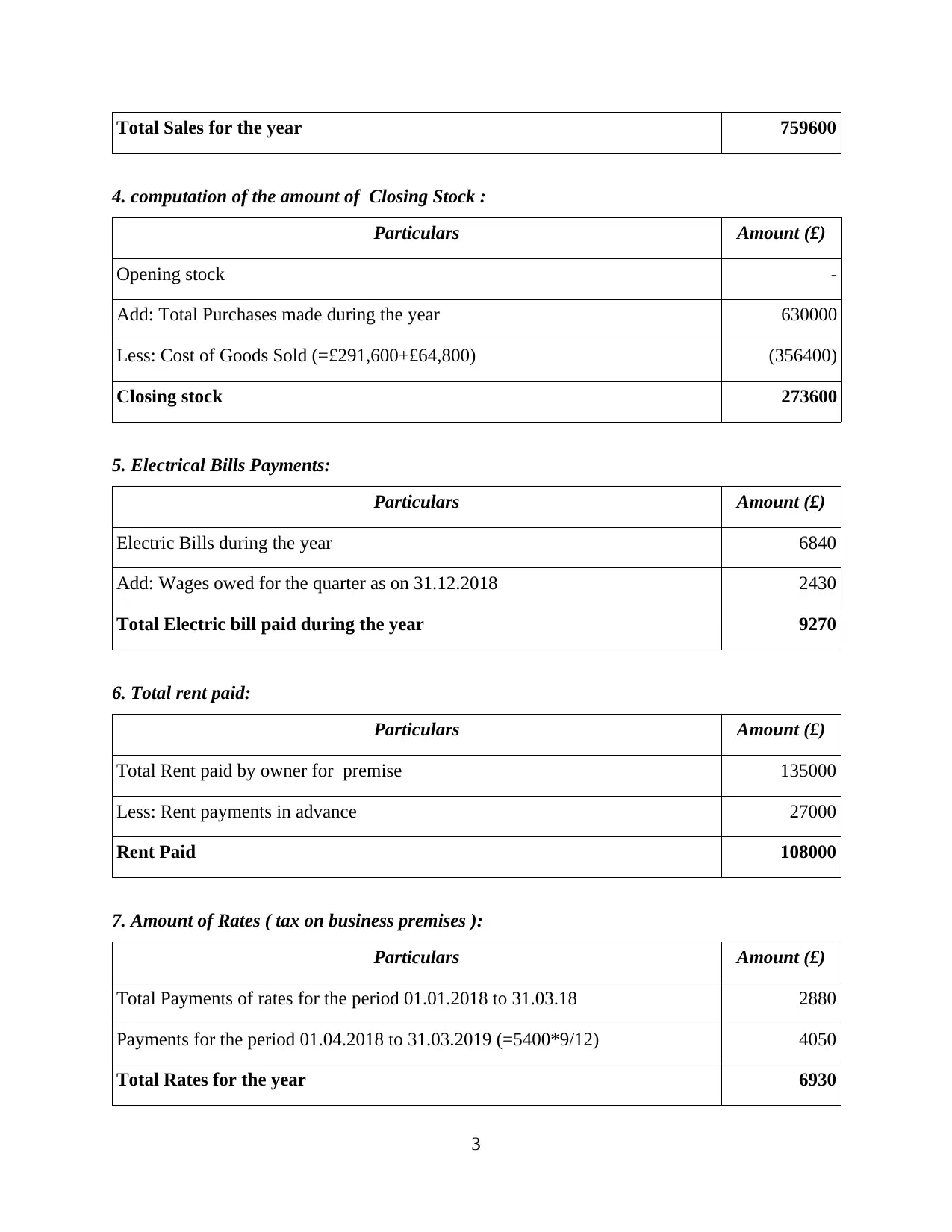
Total Sales for the year 759600
4. computation of the amount of Closing Stock :
Particulars Amount (£)
Opening stock -
Add: Total Purchases made during the year 630000
Less: Cost of Goods Sold (=£291,600+£64,800) (356400)
Closing stock 273600
5. Electrical Bills Payments:
Particulars Amount (£)
Electric Bills during the year 6840
Add: Wages owed for the quarter as on 31.12.2018 2430
Total Electric bill paid during the year 9270
6. Total rent paid:
Particulars Amount (£)
Total Rent paid by owner for premise 135000
Less: Rent payments in advance 27000
Rent Paid 108000
7. Amount of Rates ( tax on business premises ):
Particulars Amount (£)
Total Payments of rates for the period 01.01.2018 to 31.03.18 2880
Payments for the period 01.04.2018 to 31.03.2019 (=5400*9/12) 4050
Total Rates for the year 6930
3
4. computation of the amount of Closing Stock :
Particulars Amount (£)
Opening stock -
Add: Total Purchases made during the year 630000
Less: Cost of Goods Sold (=£291,600+£64,800) (356400)
Closing stock 273600
5. Electrical Bills Payments:
Particulars Amount (£)
Electric Bills during the year 6840
Add: Wages owed for the quarter as on 31.12.2018 2430
Total Electric bill paid during the year 9270
6. Total rent paid:
Particulars Amount (£)
Total Rent paid by owner for premise 135000
Less: Rent payments in advance 27000
Rent Paid 108000
7. Amount of Rates ( tax on business premises ):
Particulars Amount (£)
Total Payments of rates for the period 01.01.2018 to 31.03.18 2880
Payments for the period 01.04.2018 to 31.03.2019 (=5400*9/12) 4050
Total Rates for the year 6930
3
⊘ This is a preview!⊘
Do you want full access?
Subscribe today to unlock all pages.

Trusted by 1+ million students worldwide
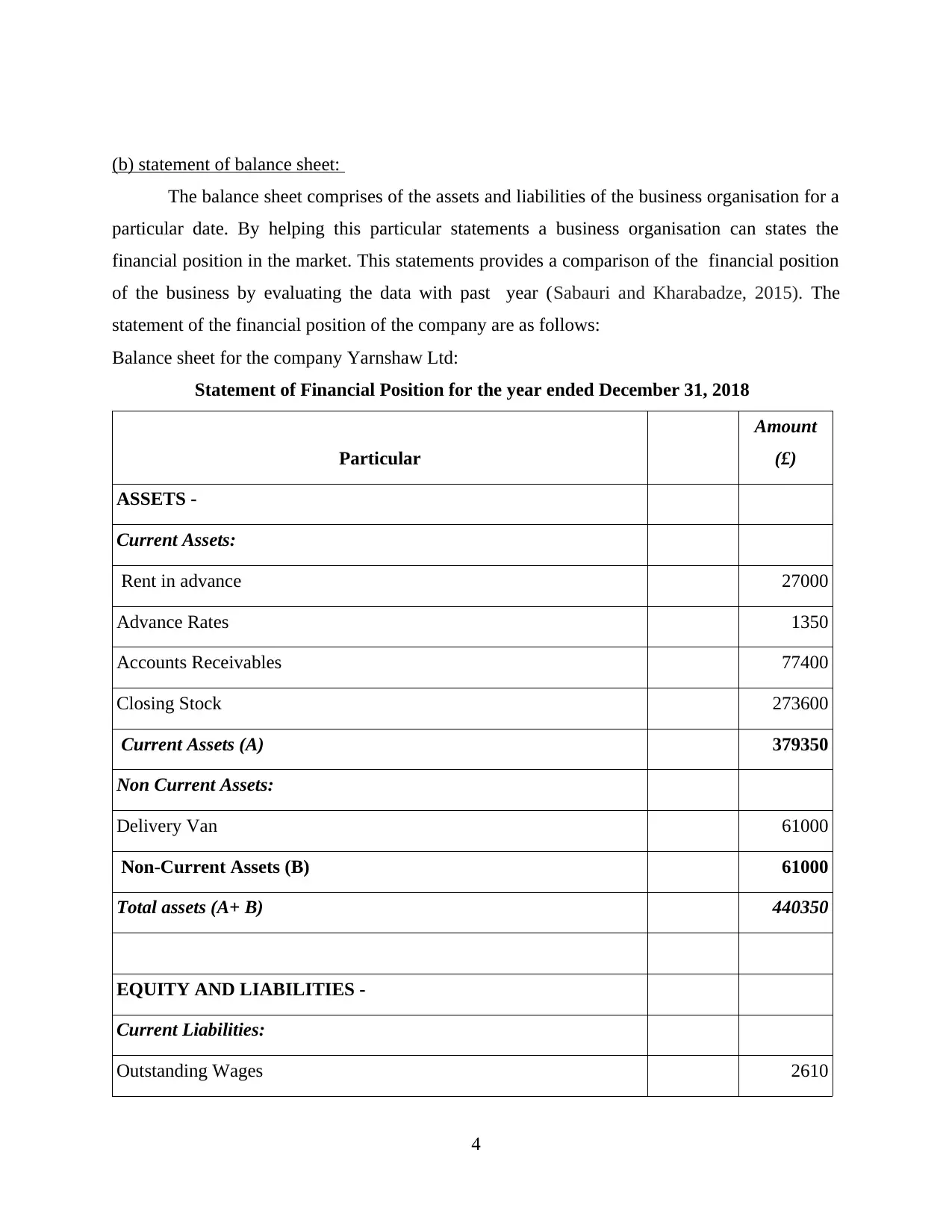
(b) statement of balance sheet:
The balance sheet comprises of the assets and liabilities of the business organisation for a
particular date. By helping this particular statements a business organisation can states the
financial position in the market. This statements provides a comparison of the financial position
of the business by evaluating the data with past year (Sabauri and Kharabadze, 2015). The
statement of the financial position of the company are as follows:
Balance sheet for the company Yarnshaw Ltd:
Statement of Financial Position for the year ended December 31, 2018
Particular
Amount
(£)
ASSETS -
Current Assets:
Rent in advance 27000
Advance Rates 1350
Accounts Receivables 77400
Closing Stock 273600
Current Assets (A) 379350
Non Current Assets:
Delivery Van 61000
Non-Current Assets (B) 61000
Total assets (A+ B) 440350
EQUITY AND LIABILITIES -
Current Liabilities:
Outstanding Wages 2610
4
The balance sheet comprises of the assets and liabilities of the business organisation for a
particular date. By helping this particular statements a business organisation can states the
financial position in the market. This statements provides a comparison of the financial position
of the business by evaluating the data with past year (Sabauri and Kharabadze, 2015). The
statement of the financial position of the company are as follows:
Balance sheet for the company Yarnshaw Ltd:
Statement of Financial Position for the year ended December 31, 2018
Particular
Amount
(£)
ASSETS -
Current Assets:
Rent in advance 27000
Advance Rates 1350
Accounts Receivables 77400
Closing Stock 273600
Current Assets (A) 379350
Non Current Assets:
Delivery Van 61000
Non-Current Assets (B) 61000
Total assets (A+ B) 440350
EQUITY AND LIABILITIES -
Current Liabilities:
Outstanding Wages 2610
4
Paraphrase This Document
Need a fresh take? Get an instant paraphrase of this document with our AI Paraphraser
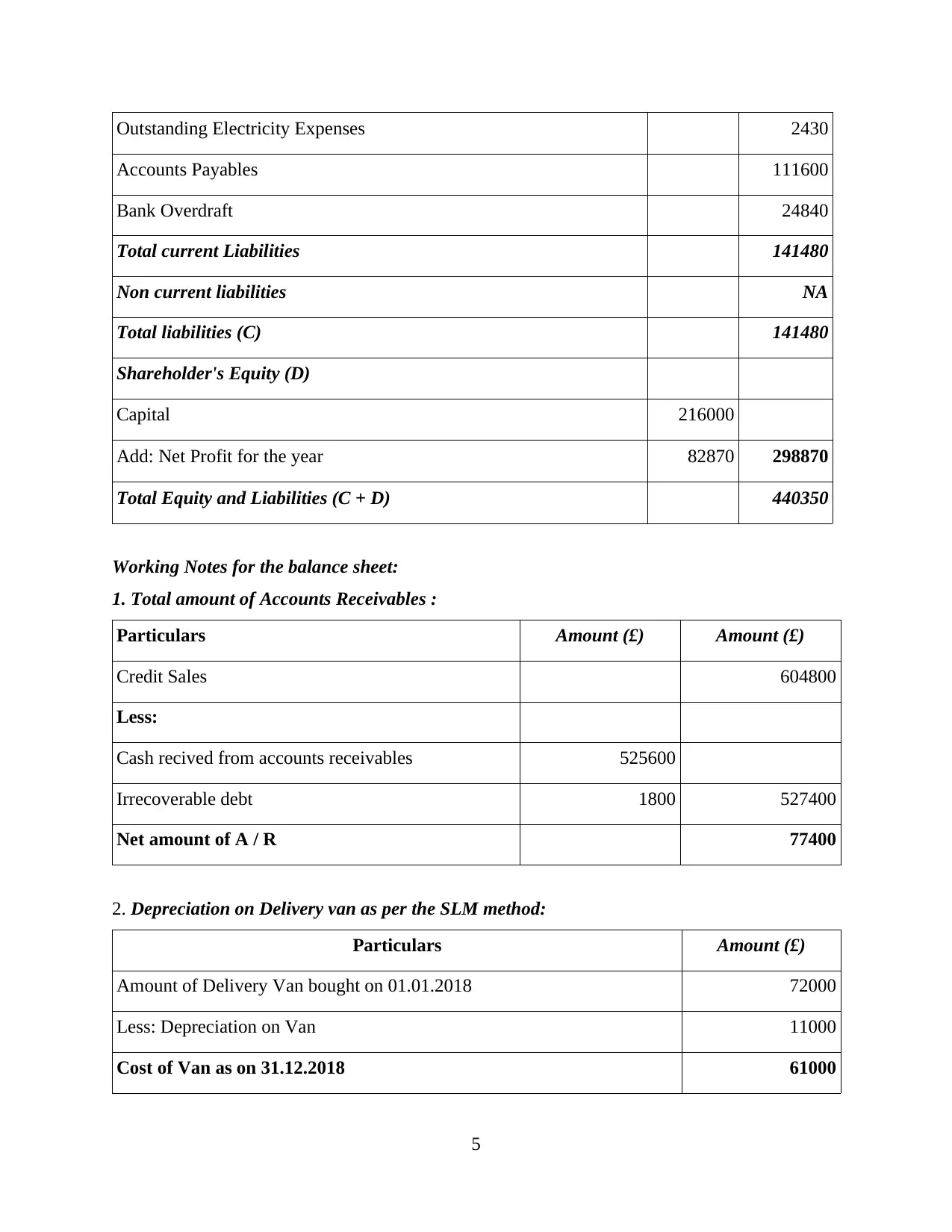
Outstanding Electricity Expenses 2430
Accounts Payables 111600
Bank Overdraft 24840
Total current Liabilities 141480
Non current liabilities NA
Total liabilities (C) 141480
Shareholder's Equity (D)
Capital 216000
Add: Net Profit for the year 82870 298870
Total Equity and Liabilities (C + D) 440350
Working Notes for the balance sheet:
1. Total amount of Accounts Receivables :
Particulars Amount (£) Amount (£)
Credit Sales 604800
Less:
Cash recived from accounts receivables 525600
Irrecoverable debt 1800 527400
Net amount of A / R 77400
2. Depreciation on Delivery van as per the SLM method:
Particulars Amount (£)
Amount of Delivery Van bought on 01.01.2018 72000
Less: Depreciation on Van 11000
Cost of Van as on 31.12.2018 61000
5
Accounts Payables 111600
Bank Overdraft 24840
Total current Liabilities 141480
Non current liabilities NA
Total liabilities (C) 141480
Shareholder's Equity (D)
Capital 216000
Add: Net Profit for the year 82870 298870
Total Equity and Liabilities (C + D) 440350
Working Notes for the balance sheet:
1. Total amount of Accounts Receivables :
Particulars Amount (£) Amount (£)
Credit Sales 604800
Less:
Cash recived from accounts receivables 525600
Irrecoverable debt 1800 527400
Net amount of A / R 77400
2. Depreciation on Delivery van as per the SLM method:
Particulars Amount (£)
Amount of Delivery Van bought on 01.01.2018 72000
Less: Depreciation on Van 11000
Cost of Van as on 31.12.2018 61000
5

Depreciation on delivery as per SLM :
= cost of the assets – salvage value / useful life of the assets
= 72000 – 6000 / 6 = 11000
3. Total amount of the Accounts Payable:
Particular Amount (£)
Total amount of credit purchase 583200
Less: Amount paid during the year to debtors 471600
Accounts Payables 111600
4. closing balance of Cash and Cash Equivalents:
Cash / Bank Account
Particular
Amount
(£) Particular Amount (£)
To Capital Account 216000 By Purchases 46800
To Cash recived from account
receivables 525600 By Cash paid to suppliers 471600
To Sales in cash 154800 By Expenses of Delivery van 40320
To Balance C/d (Overdraft) 24840 By Wages paid 140400
By Electricity Bill Expenses 6840
By Rates 8280
By Rent 135000
By Purchase of Delivery Van 72000
921240 921240
6
= cost of the assets – salvage value / useful life of the assets
= 72000 – 6000 / 6 = 11000
3. Total amount of the Accounts Payable:
Particular Amount (£)
Total amount of credit purchase 583200
Less: Amount paid during the year to debtors 471600
Accounts Payables 111600
4. closing balance of Cash and Cash Equivalents:
Cash / Bank Account
Particular
Amount
(£) Particular Amount (£)
To Capital Account 216000 By Purchases 46800
To Cash recived from account
receivables 525600 By Cash paid to suppliers 471600
To Sales in cash 154800 By Expenses of Delivery van 40320
To Balance C/d (Overdraft) 24840 By Wages paid 140400
By Electricity Bill Expenses 6840
By Rates 8280
By Rent 135000
By Purchase of Delivery Van 72000
921240 921240
6
⊘ This is a preview!⊘
Do you want full access?
Subscribe today to unlock all pages.

Trusted by 1+ million students worldwide

PART-B: RECKTURK PLC
(a ) Computation of the contribution per unit for wardrobe made towards covering fixed costs
when selling price is £ 40 per unit -
Particulars
Cost per
unit
Actual
production
(£)
Budgeted
production
(£)
Total Units Produced 78000 60000
Total Sales (A) 40.00 3120000 2400000
Material 15.75 1228500 945000
Labour 8.85 690300 531000
Variable Overhead 5.55 432900 333000
Total Variable Costs (B) 2351700 1809000
Contribution [(C) = (A)-(B)] 768300 591000
Contribution per unit [(D) = (C)/Units Produced] 9.85 9.85
Thus, the contribution is 9.85 £ per unit by considering the selling price is 40 in the both cases as
actual and budgeted.
(b). Calculation of the Break-even Point and Margin of Safety for the both unit of production
when selling price is £40 -
Break-even Point (BEP):
(i) In units of Wardrobe:
7
(a ) Computation of the contribution per unit for wardrobe made towards covering fixed costs
when selling price is £ 40 per unit -
Particulars
Cost per
unit
Actual
production
(£)
Budgeted
production
(£)
Total Units Produced 78000 60000
Total Sales (A) 40.00 3120000 2400000
Material 15.75 1228500 945000
Labour 8.85 690300 531000
Variable Overhead 5.55 432900 333000
Total Variable Costs (B) 2351700 1809000
Contribution [(C) = (A)-(B)] 768300 591000
Contribution per unit [(D) = (C)/Units Produced] 9.85 9.85
Thus, the contribution is 9.85 £ per unit by considering the selling price is 40 in the both cases as
actual and budgeted.
(b). Calculation of the Break-even Point and Margin of Safety for the both unit of production
when selling price is £40 -
Break-even Point (BEP):
(i) In units of Wardrobe:
7
Paraphrase This Document
Need a fresh take? Get an instant paraphrase of this document with our AI Paraphraser
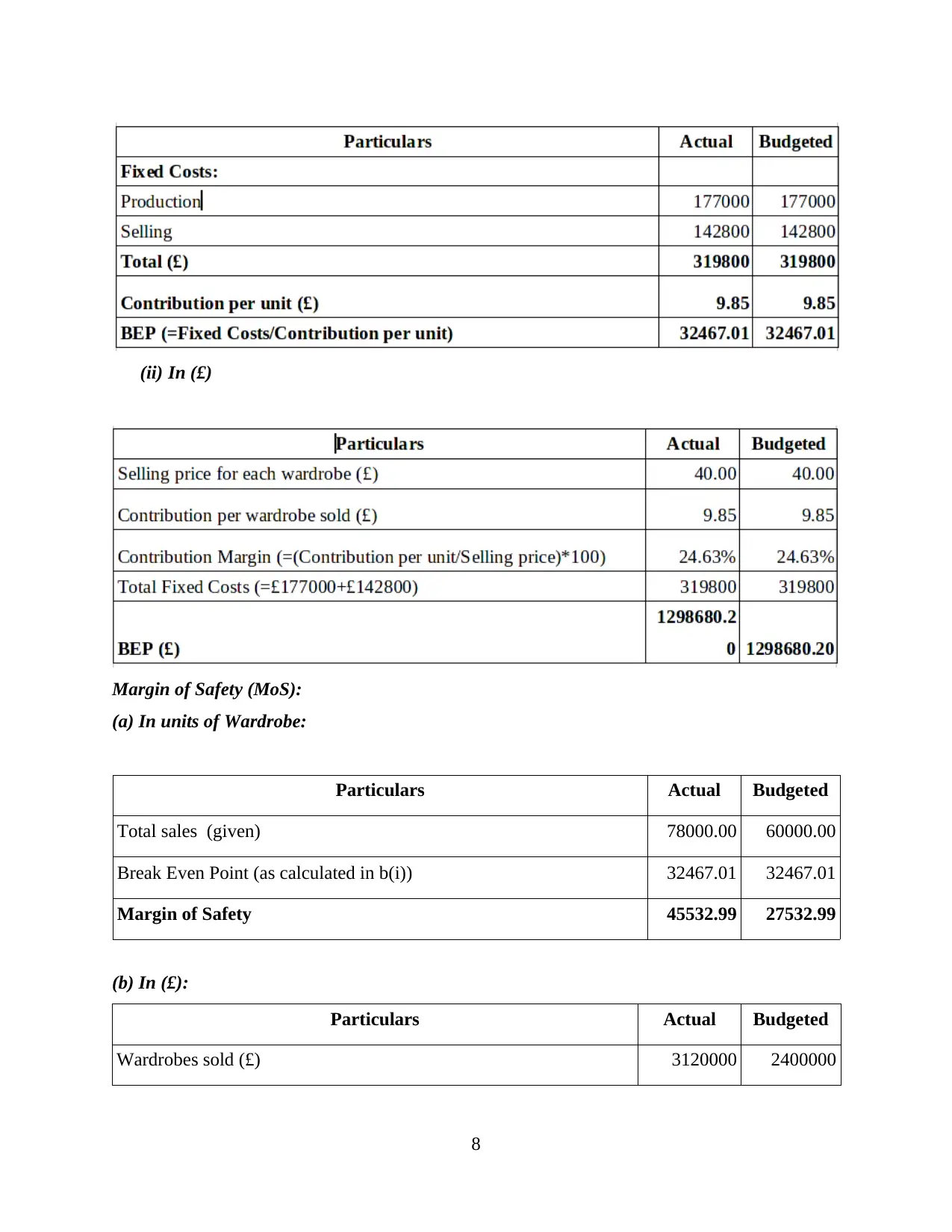
(ii) In (£)
Margin of Safety (MoS):
(a) In units of Wardrobe:
Particulars Actual Budgeted
Total sales (given) 78000.00 60000.00
Break Even Point (as calculated in b(i)) 32467.01 32467.01
Margin of Safety 45532.99 27532.99
(b) In (£):
Particulars Actual Budgeted
Wardrobes sold (£) 3120000 2400000
8
Margin of Safety (MoS):
(a) In units of Wardrobe:
Particulars Actual Budgeted
Total sales (given) 78000.00 60000.00
Break Even Point (as calculated in b(i)) 32467.01 32467.01
Margin of Safety 45532.99 27532.99
(b) In (£):
Particulars Actual Budgeted
Wardrobes sold (£) 3120000 2400000
8
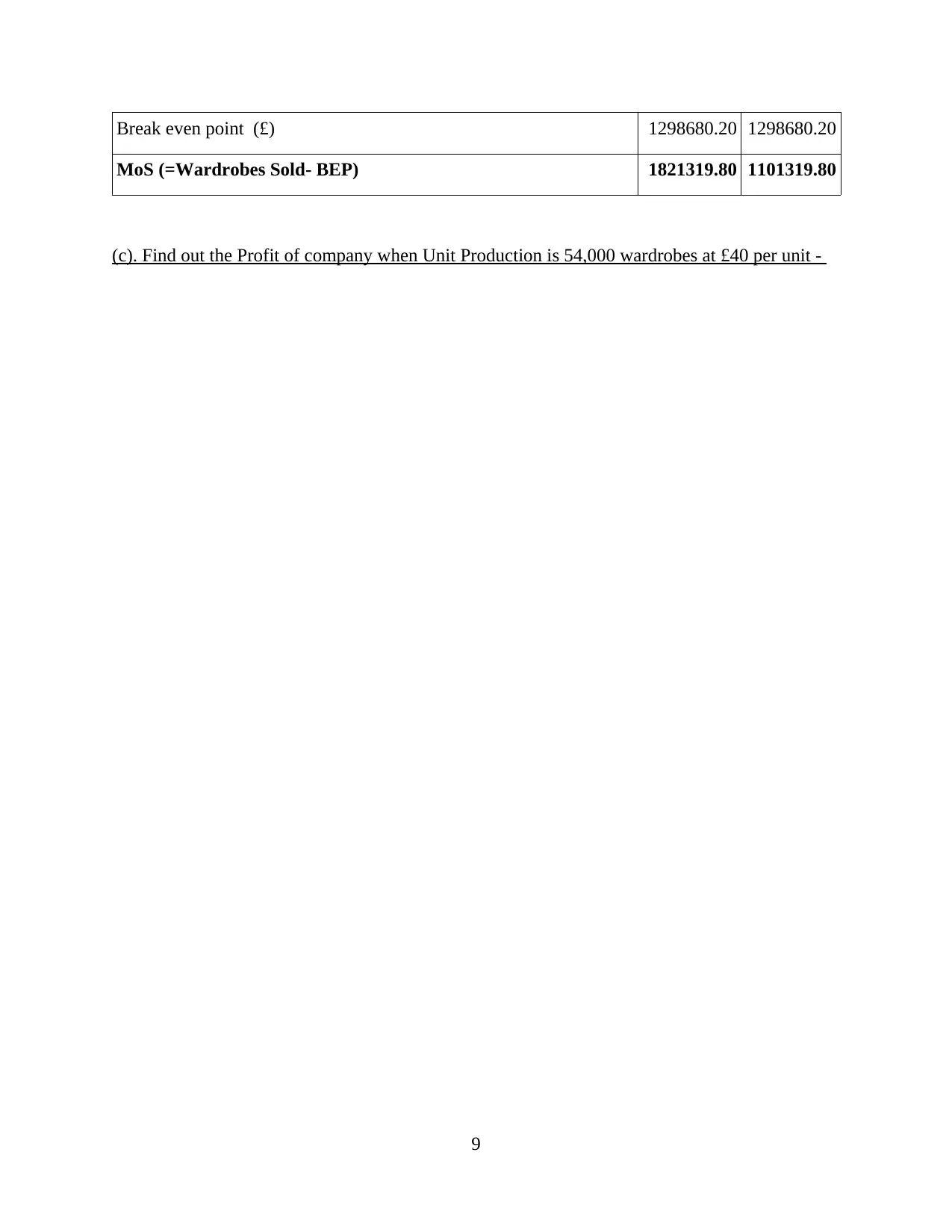
Break even point (£) 1298680.20 1298680.20
MoS (=Wardrobes Sold- BEP) 1821319.80 1101319.80
(c). Find out the Profit of company when Unit Production is 54,000 wardrobes at £40 per unit -
9
MoS (=Wardrobes Sold- BEP) 1821319.80 1101319.80
(c). Find out the Profit of company when Unit Production is 54,000 wardrobes at £40 per unit -
9
⊘ This is a preview!⊘
Do you want full access?
Subscribe today to unlock all pages.

Trusted by 1+ million students worldwide
1 out of 19
Related Documents
Your All-in-One AI-Powered Toolkit for Academic Success.
+13062052269
info@desklib.com
Available 24*7 on WhatsApp / Email
![[object Object]](/_next/static/media/star-bottom.7253800d.svg)
Unlock your academic potential
Copyright © 2020–2025 A2Z Services. All Rights Reserved. Developed and managed by ZUCOL.





